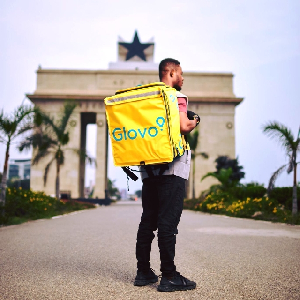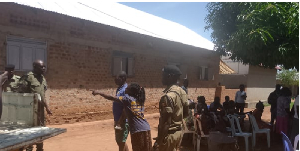- Home - News
- TWI News | TV
- Polls
- Year In Review
- News Archive
- Crime & Punishment
- Politics
- Regional
- Editorial
- Health
- Ghanaians Abroad
- Tabloid
- Africa
- Religion
- Election 2020
- Coronavirus
- News Videos | TV
- Photo Archives
- News Headlines
- Press Release
General News of Saturday, 13 November 1999
Source: Reuters
1999/2000 cocoa late but looks good -trade
By Vincent t'Sas
KUMASI, Ghana, Nov 12 (Reuters) - Harvesting of 1999/2000 (Oct/Sept) cocoa in Ghana has started slightly later than usual and dry season rain has affected trees in some areas, but the crop could well be up on last season, farmers and traders say.
``The crop is a bit late,'' said one Accra-based buyer. ``Later in the month purchases are going to pick up and I expect that we will still be buying heavily late January,'' he said.
He forecast a total crop of 415,000 tonnes, in line with the official Ghana Cocoa Marketing Board (COCOBOD) forecast of 400-420,000 and up on last season's output of around 380,000.
Farmers and buyers along the Accra-Kumasi road say rainfall in their region has helped quality and volumes at the start of the season were generally about the same as last year.
``The quality is good, as the rainfall here was better than last year,'' said one buyer in Eastern Region province. He had about 60 bags of 60 kilograms each in stock with a bean count of 89 and 96 beans per 100 grams.
The buyer said that in his region it had continued raining during the small July-August dry season, which had affected the flowering of the cocoa trees and could affect the yields.
The main dry November-February dry season should have started but it has continued raining. On Wednesday there were heavy downpours along the Accra-Kumasi road.
``It rained yesterday (Tuesday), too. There has been continuous rainfall so we have black pod,'' the buyer said.
Farmers in the region showed Reuters pods affected by black pod rot. However, if harvested in time, the disease does not affect the beans, they said, and the beans tasted juicy.
REASEARCHERS TACKLING COCOA DISEASES
Black pod and swollen shoot are the two main diseases cutting output in Ghana, but researchers are tackling them.
``We are promoting a technique based on reducing humidity through weeding and pruning, frequent harvesting and the use of chemicals,'' a researcher at Tafo Cocoa Research Institute said.
Chemicals are widely available thorugh a network of regional depots and stores operated by the monopoly Cocoa Inputs Company.
However, the government cut the subsidy on inputs sharply a few years back to stop smuggling to neighbouring countries and prices have soared.
Small farmers living on subsistence incomes sometimes have other priorities.
``I did not spray this year because of family problems,'' said Daniel Ansah. He had to pay for a funeral and medical treatment for several relatives. As a result he expects his 2.5 acre farm near Kumasi to produce five bags instead of the usual seven.
However, Ghanaian farmers are, as ever, still meticulous in fermenting, drying and sorting their cocoa, analysts say.
``We have no problem buying grade one, good quality cocoa,'' said a private buyer on Thursday in his Kumasi office.
Private buyers often complain about lack of funding, but he said he had been able to finance purchases through a low-interest loan from Cocobod.
Cocobod, which has a good name in financial markets, in September signed a $350 million syndicated loan agreement with 20 banks, led by Barclays Plc and Ghana Commercial Bank.
Ghana has liberalised internal cocoa marketing and has pledged to liberalise exports in part by October 2000.
The private sector will be allowed to export around 30 percent of the crop, about the same share the 21 private Licensed Buying Companies currently have in internal marketing.










